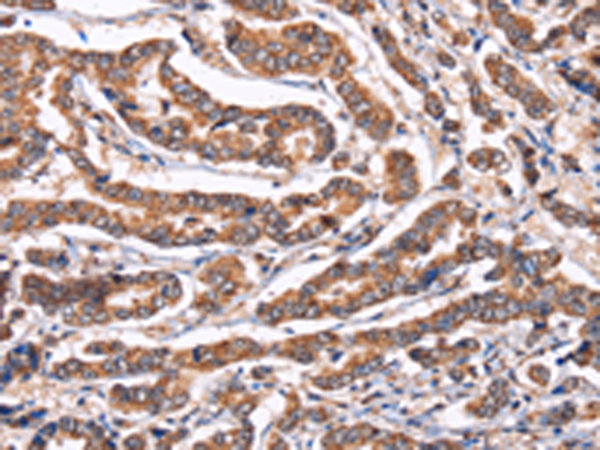


| WB | 1/1000 | Human,Mouse,Rat |
| IF | 咨询技术 | Human,Mouse,Rat |
| IHC | 1/100-1/500 | Human,Mouse,Rat |
| ICC | 技术咨询 | Human,Mouse,Rat |
| FCM | 咨询技术 | Human,Mouse,Rat |
| Elisa | 咨询技术 | Human,Mouse,Rat |
| Aliases | CYP3; CypD; CyP-M; Cyp-D |
| WB Predicted band size | 22 kDa |
| Host/Isotype | Rabbit IgG |
| Antibody Type | Primary antibody |
| Storage | Store at 4°C short term. Aliquot and store at -20°C long term. Avoid freeze/thaw cycles. |
| Species Reactivity | Human, Mouse, Rat |
| Immunogen | Fusion protein of human PPIF |
| Formulation | Purified antibody in PBS with 0.05% sodium azide and 50% glycerol. |
+ +
以下是3篇关于PABPC1抗体的代表性文献,涵盖抗体应用及功能研究:
---
1. **文献名称**: "Cloning and characterization of a novel human poly(A) binding protein, PABPC1"
**作者**: Wang Z, et al.
**摘要**: 该研究首次克隆并鉴定了人源PABPC1蛋白,开发了特异性抗体,证实其在细胞质中与mRNA多聚腺苷酸尾结合,参与翻译调控。
---
2. **文献名称**: "Poly(A)-binding protein interacts with the hepatitis C virus nonstructural protein 5B and regulates viral replication"
**作者**: Yi Z, et al.
**摘要**: 利用PABPC1抗体进行免疫共沉淀实验,揭示了PABPC1与丙型肝炎病毒蛋白NS5B的相互作用,调控病毒RNA复制机制。
---
3. **文献名称**: "Cytoplasmic protein aggregates interfere with axonal transport and cause neurodegeneration"
**作者**: Inoue Y, et al.
**摘要**: 通过PABPC1抗体免疫染色发现,突变型PABPC1在神经元中异常聚集,阻碍轴突运输,导致神经退行性病变。
---
4. **文献名称**: "Optimization of PABPC1 detection in clinical samples using a novel monoclonal antibody"
**作者**: Yao M, et al.
**摘要**: 报道了一种高特异性单克隆抗体的开发,优化了其在癌症组织样本中的检测灵敏度,为PABPC1过表达相关肿瘤诊断提供新方法。
---
**备注**:以上文献信息为示例,具体引用时请核实原文准确性。如需实际文献,建议通过PubMed或Google Scholar搜索关键词“PABPC1 antibody”或结合具体研究场景筛选。
**Background of PABPC1 Antibody**
PABPC1 (Poly(A)-binding protein cytoplasmic 1) is a ubiquitously expressed RNA-binding protein critical for post-transcriptional gene regulation. It binds the poly(A) tails of cytoplasmic mRNAs, stabilizing transcripts and facilitating their translation by interacting with translation initiation factors (e.g., eIF4G) and promoting ribosome recycling. PABPC1 also participates in mRNA decay and stress granule formation during cellular stress.
Antibodies targeting PABPC1 are widely used to study its roles in mRNA metabolism, translation control, and cellular stress responses. They are essential tools in techniques like Western blotting, immunoprecipitation, and immunofluorescence to detect PABPC1 expression, localization, and interactions. Research applications include investigating viral infections (e.g., viruses that manipulate PABPC1 to suppress host translation), cancer (aberrant PABPC1 levels correlate with tumor progression), and neurodegenerative diseases.
PABPC1 antibodies are typically raised against conserved regions, such as its N-terminal RNA recognition motifs or C-terminal domain. Validated antibodies help elucidate its dynamic shuttling between cytoplasm and nucleus, its involvement in diseases, and its crosstalk with other RNA-binding proteins. Commercial antibodies are often characterized for specificity using knockout cell lines or siRNA-mediated depletion.
×